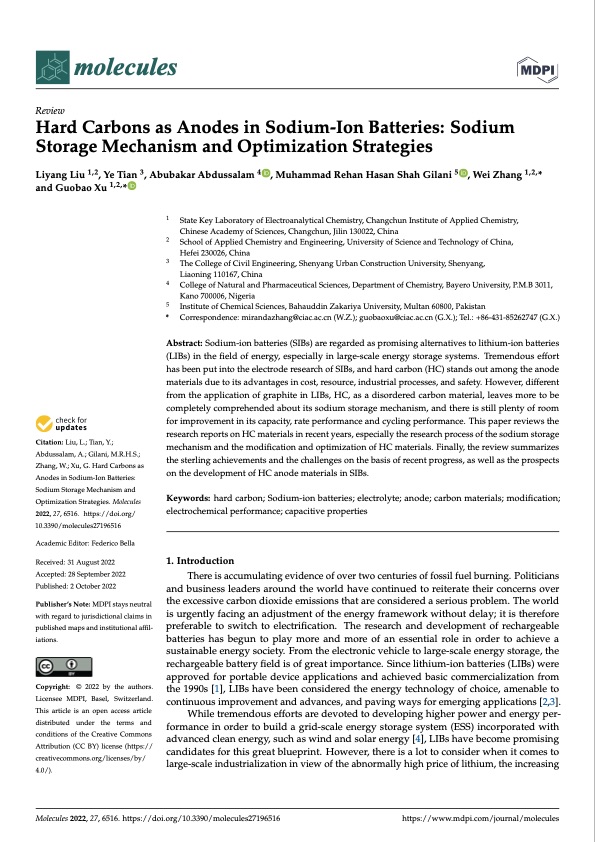
PDF Publication Title:
Text from PDF Page: 001
molecules Review Hard Carbons as Anodes in Sodium-Ion Batteries: Sodium Storage Mechanism and Optimization Strategies Liyang Liu 1,2, Ye Tian 3, Abubakar Abdussalam 4 , Muhammad Rehan Hasan Shah Gilani 5 , Wei Zhang 1,2,* and Guobao Xu 1,2,* 1 2 3 4 5 * Correspondence: mirandazhang@ciac.ac.cn (W.Z.); guobaoxu@ciac.ac.cn (G.X.); Tel.: +86-431-85262747 (G.X.) Abstract: Sodium-ion batteries (SIBs) are regarded as promising alternatives to lithium-ion batteries (LIBs) in the field of energy, especially in large-scale energy storage systems. Tremendous effort has been put into the electrode research of SIBs, and hard carbon (HC) stands out among the anode materials due to its advantages in cost, resource, industrial processes, and safety. However, different from the application of graphite in LIBs, HC, as a disordered carbon material, leaves more to be completely comprehended about its sodium storage mechanism, and there is still plenty of room for improvement in its capacity, rate performance and cycling performance. This paper reviews the research reports on HC materials in recent years, especially the research process of the sodium storage mechanism and the modification and optimization of HC materials. Finally, the review summarizes the sterling achievements and the challenges on the basis of recent progress, as well as the prospects on the development of HC anode materials in SIBs. Keywords: hard carbon; Sodium-ion batteries; electrolyte; anode; carbon materials; modification; electrochemical performance; capacitive properties 1. Introduction There is accumulating evidence of over two centuries of fossil fuel burning. Politicians and business leaders around the world have continued to reiterate their concerns over the excessive carbon dioxide emissions that are considered a serious problem. The world is urgently facing an adjustment of the energy framework without delay; it is therefore preferable to switch to electrification. The research and development of rechargeable batteries has begun to play more and more of an essential role in order to achieve a sustainable energy society. From the electronic vehicle to large-scale energy storage, the rechargeable battery field is of great importance. Since lithium-ion batteries (LIBs) were approved for portable device applications and achieved basic commercialization from the 1990s [1], LIBs have been considered the energy technology of choice, amenable to continuous improvement and advances, and paving ways for emerging applications [2,3]. While tremendous efforts are devoted to developing higher power and energy per- formance in order to build a grid-scale energy storage system (ESS) incorporated with advanced clean energy, such as wind and solar energy [4], LIBs have become promising candidates for this great blueprint. However, there is a lot to consider when it comes to large-scale industrialization in view of the abnormally high price of lithium, the increasing State Key Laboratory of Electroanalytical Chemistry, Changchun Institute of Applied Chemistry, Chinese Academy of Sciences, Changchun, Jilin 130022, China School of Applied Chemistry and Engineering, University of Science and Technology of China, Hefei 230026, China The College of Civil Engineering, Shenyang Urban Construction University, Shenyang, Liaoning 110167, China College of Natural and Pharmaceutical Sciences, Department of Chemistry, Bayero University, P.M.B 3011, Kano 700006, Nigeria Institute of Chemical Sciences, Bahauddin Zakariya University, Multan 60800, Pakistan Citation: Liu, L.; Tian, Y.; Abdussalam, A.; Gilani, M.R.H.S.; Zhang, W.; Xu, G. Hard Carbons as Anodes in Sodium-Ion Batteries: Sodium Storage Mechanism and Optimization Strategies. Molecules 2022,27,6516. https://doi.org/ 10.3390/molecules27196516 Academic Editor: Federico Bella Received: 31 August 2022 Accepted: 28 September 2022 Published: 2 October 2022 Publisher’s Note: MDPI stays neutral with regard to jurisdictional claims in published maps and institutional affil- iations. Copyright: © 2022 by the authors. Licensee MDPI, Basel, Switzerland. This article is an open access article distributed under the terms and conditions of the Creative Commons Attribution (CC BY) license (https:// creativecommons.org/licenses/by/ 4.0/). Molecules 2022, 27, 6516. https://doi.org/10.3390/molecules27196516 https://www.mdpi.com/journal/moleculesPDF Image | Hard Carbons as Anodes in Sodium-Ion Batteries

PDF Search Title:
Hard Carbons as Anodes in Sodium-Ion BatteriesOriginal File Name Searched:
molecules-27-06516-v2.pdfDIY PDF Search: Google It | Yahoo | Bing
Salgenx Redox Flow Battery Technology: Salt water flow battery technology with low cost and great energy density that can be used for power storage and thermal storage. Let us de-risk your production using our license. Our aqueous flow battery is less cost than Tesla Megapack and available faster. Redox flow battery. No membrane needed like with Vanadium, or Bromine. Salgenx flow battery
| CONTACT TEL: 608-238-6001 Email: greg@salgenx.com | RSS | AMP |